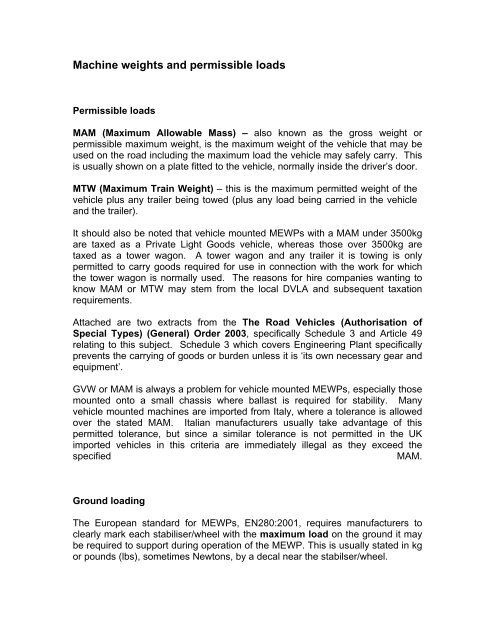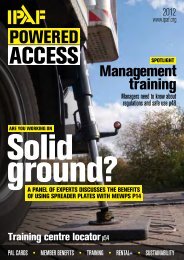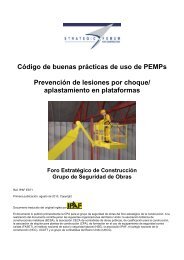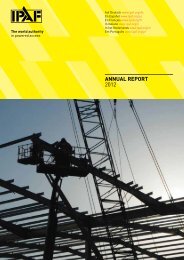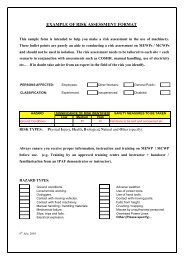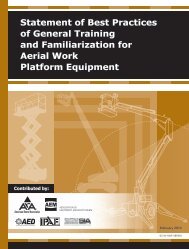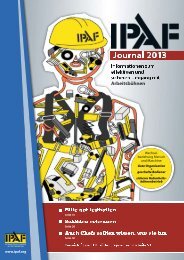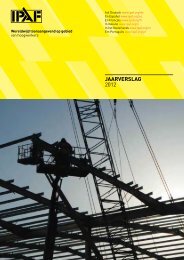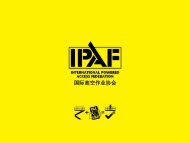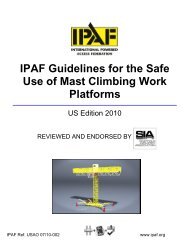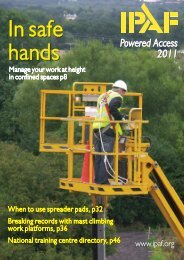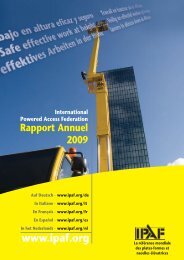Machine weights and permissible loads - IPAF
Machine weights and permissible loads - IPAF
Machine weights and permissible loads - IPAF
You also want an ePaper? Increase the reach of your titles
YUMPU automatically turns print PDFs into web optimized ePapers that Google loves.
<strong>Machine</strong> <strong>weights</strong> <strong>and</strong> <strong>permissible</strong> <strong>loads</strong><br />
Permissible <strong>loads</strong><br />
MAM (Maximum Allowable Mass) – also known as the gross weight or<br />
<strong>permissible</strong> maximum weight, is the maximum weight of the vehicle that may be<br />
used on the road including the maximum load the vehicle may safely carry. This<br />
is usually shown on a plate fitted to the vehicle, normally inside the driver’s door.<br />
MTW (Maximum Train Weight) – this is the maximum permitted weight of the<br />
vehicle plus any trailer being towed (plus any load being carried in the vehicle<br />
<strong>and</strong> the trailer).<br />
It should also be noted that vehicle mounted MEWPs with a MAM under 3500kg<br />
are taxed as a Private Light Goods vehicle, whereas those over 3500kg are<br />
taxed as a tower wagon. A tower wagon <strong>and</strong> any trailer it is towing is only<br />
permitted to carry goods required for use in connection with the work for which<br />
the tower wagon is normally used. The reasons for hire companies wanting to<br />
know MAM or MTW may stem from the local DVLA <strong>and</strong> subsequent taxation<br />
requirements.<br />
Attached are two extracts from the The Road Vehicles (Authorisation of<br />
Special Types) (General) Order 2003, specifically Schedule 3 <strong>and</strong> Article 49<br />
relating to this subject. Schedule 3 which covers Engineering Plant specifically<br />
prevents the carrying of goods or burden unless it is ‘its own necessary gear <strong>and</strong><br />
equipment’.<br />
GVW or MAM is always a problem for vehicle mounted MEWPs, especially those<br />
mounted onto a small chassis where ballast is required for stability. Many<br />
vehicle mounted machines are imported from Italy, where a tolerance is allowed<br />
over the stated MAM. Italian manufacturers usually take advantage of this<br />
permitted tolerance, but since a similar tolerance is not permitted in the UK<br />
imported vehicles in this criteria are immediately illegal as they exceed the<br />
specified<br />
MAM.<br />
Ground loading<br />
The European st<strong>and</strong>ard for MEWPs, EN280:2001, requires manufacturers to<br />
clearly mark each stabiliser/wheel with the maximum load on the ground it may<br />
be required to support during operation of the MEWP. This is usually stated in kg<br />
or pounds (lbs), sometimes Newtons, by a decal near the stabilser/wheel.
To specify a ground bearing pressure of a stabiliser/wheel acting on the<br />
ground, the size of the stabiliser/wheel ‘footprint area’ must be known. The<br />
normal units used here would be kg per square metre, Newtons per square<br />
metre or pounds per square inch.<br />
P Reed 14/11/05


